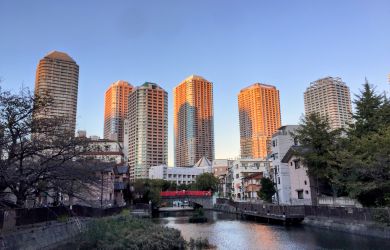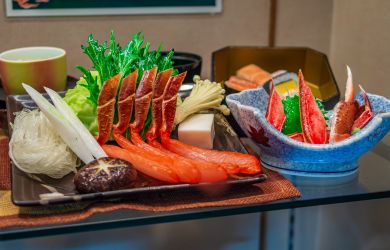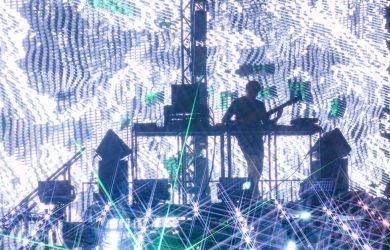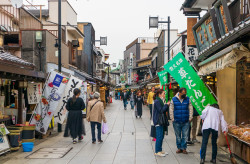
Originally published on metropolis.co.jp on March 2007

Photos by Jeffrey Tanenhaus
Although Israel grabs headlines for its perpetual religious conflicts, the country also boasts natural attractions that will suit anyone with an affinity for the outdoors.
The pinnacle of these experiences has to be climbing Masada. The area’s name is Hebrew for “fortress,” yet this is no ordinary outpost. Two thousand years before luxurious retreats were in vogue, and in defiance of the challenging climate and elevation, Herod the Great erected palaces, aqueducts, cisterns and bathhouses with hot and cold pools.
In the year 73, patriotic Jewish rebels on Masada held out for months against a Roman army 15 times larger. Facing imminent defeat and enslavement, the Zealots opted for mass suicide. Today, Masada remains a symbol of perseverance for Israelis familiar with being outnumbered and encircled by Arab states.

While I wandered about the ruins, I was drawn to the sounds of chanting from a stone alcove. A bar mitzvah, the ritual ceremony marking a Jewish boy’s 13th birthday, was underway in one of the world’s oldest synagogues.
This mountaintop is especially majestic at sunrise, when soft colors creep across the brightening sky, bathing the Judean Desert in an orange glow. The breathtaking views make for an adrenaline rush, and must have emboldened the Zealots to the very end. In the distance glimmers another landmark, the Dead Sea. These turquoise waters among the desert scenery surely invite recreation, but some resist the urge, as salt concentrations almost nine times that of the ocean makes “dead” an apt description for this lifeless lake. The sea is not just salty—at 418m below sea level (and falling), its receding shores are the lowest dry place on Earth.

The water’s unique properties would enable sumo wrestlers to bob like corks. As a result, even those who can’t doggy paddle can enjoy the thrill of effortless buoyancy. Since jagged salt chunks line the lakebed, it’s advisable to wear sandals—you know what they say about sticking salt in an open wound.
As the sea’s minerals and mud are chock full of health-promoting properties, a store called Ahava, at the base of Masada, offers one-stop shopping for skin products. Women aren’t the only ones to benefit from the emollients and unguents—even the most macho males would be wise to stock up on aftershaves, moisturizers and cleansers that leave one feeling rejuvenated.
For those seeking freshwater refreshment, the nearby nature reserve of Ein Gedi is popular with hikers. The 2,529-hectare oasis teems with desert wildlife visible upon arrival, like the long-horned ibex patrolling the parking lot. The area’s numerous waterfalls and natural pools are a welcoming contrast to the baking plains.
Sometimes the only way to beat the heat is to head underground. Beit Guvrin National Park allows the archeologist in all of us to “Dig for a Day” (three hours), excavating pottery shards dating from the Hellenistic period. Spelunkers can then test their agility by slithering through labyrinthine caverns. Crawling face to the floor is the only way to pass some of the narrowest points.
For some, being immersed in Mother Nature qualifies as a religious experience. Others, however, will seek spirituality in the ancient quarters of Jerusalem. Here lies the historical center of Christianity and Judaism, sacred to Muslims as well. Since biblical times, the city has weathered a steady storm of ethnic and religious strife, as Egyptians, Babylonians, Romans, European crusaders, Turks, Brits, Jordanians, Israelis and Palestinians have kept “The City of Peace” anything but peaceable.
At this crossroads of civilization, history infused with religion hangs in the air. Self-guided walking tours of the Old City can be tailored to one’s interest, highlighting the Church of the Holy Sepulchre, Temple Mount and the Western Wall.
Jerusalem attracts hordes of multi-national pilgrims. I met Jews born in countries from Argentina to Yemen, while those from Brazil, Ethiopia, India and Kurdistan had emigrated from places I never realized had native Jewish populations. Such are the many faces of Israel.
While more than 75 percent of the country’s 6.3 million people identify themselves as Jewish, there are degrees of devotion. Orthodox men sporting black hats, beards and curly earlocks share sidewalks with less traditional adherents wearing t-shirts and jeans.
Religious diversity and a storied history are the most striking things about this ancient confluence of cultures. Whether it’s in houses of worship or buoyancy in the Dead Sea, spirituality permeates Israel.
Stay abreast of the region’s fast-changing political and security situation. Although a small state, Israel’s climate and terrain vary greatly from the Mediterranean coast to the mountainous north. The months of November to March generally bring cooler temperatures and more rain, while summers are hot and dry. The Roman Ramp is the easiest way to summit Masada on foot. To descend, opt for the cable car or brave the scorching sun for 700 steps along the sinuous yet scenic Snake Path, and get a taste of what the Romans faced trying to overtake the Zealots.
[geo_mashup_map]







